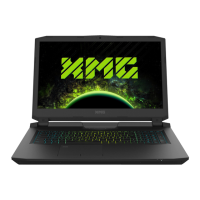Thunderbolt Port Devices
When plugging a device into a Thunderbolt port allow 30 seconds for the system to scan and recognize the connected
device.
You can enable/disable the Thunderbolt port in the BIOS (see “Intel(R) Thunderbolt Technology (Advanced Menu >
Intel(R) Thunderbolt)” on page 5 - 11), and disabling the port will also disable its functionality as a USB port. If you
want to use the Thunderbolt port to support display devices then you will need to set it up in the BIOS (see “DDI Control
(Advanced Menu > Advanced Chipset Control)” on page 5 - 10). When the Thunderbolt port is set to be used for
display only, then DisplayPort 1 ( in Figure 1 - 7 on page 1 - 15) will be disabled. You can also set the level of
security for the Thunderbolt port in the BIOS.
Ejecting Thunderbolt Devices
In order to prevent system problems make sure you do not simply pull the cable out from the Thunderbolt port. The
hardware must be ejected safely:
1. Go to the notification area of the taskbar in the Desktop App and click on the Safely Remove Hardware and Eject
Media icon.
2. Click on Eject “Thunderbolt Device Name”.
3. When you see the “Safe to Remove Hardware” message you can remove the cable after about 20 seconds, to
make sure that it is safe to eject the device.

